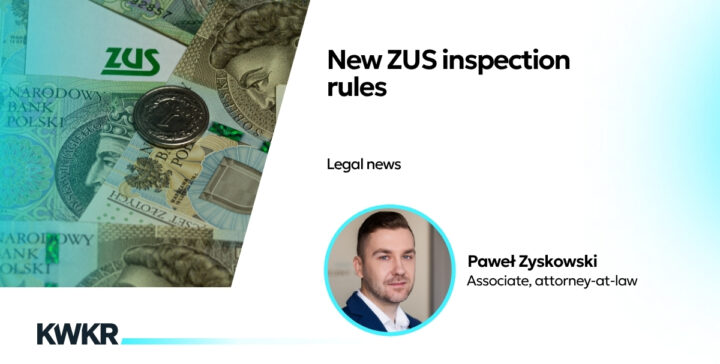New ZUS inspection rules – risk-based categorization of entrepreneurs, 2026 control plan, and self-employment under scrutiny
The new ZUS (Social Insurance Institution) inspection rules are now in force – micro-entrepreneurs can expect shorter and more predictable inspections. However, concerns are rising over ZUS’s widely discussed inspection plan for 2026, which will be based on risk categories and focus, among other things, on civil-law contracts and fictitious self-employment (B2B arrangements).

Economic law reform as of July 2025
As of July 13, 2025, part of the provisions of the Act of May 21, 2025 on the amendment of certain acts aimed at the deregulation of economic and administrative law and the improvement of the principles for drafting economic law (Journal of Laws 2025, item 769) entered into force.
This is the so-called “deregulation act”, the purpose of which is to reduce excessive administrative obligations imposed on entrepreneurs, simplify procedures and increase the predictability of inspections carried out by authorities such as the Social Insurance Institution (ZUS) or the National Labour Inspectorate (PIP).
The remaining provisions of the act will enter into force on January 1, 2026 and after nine months from its publication.
Shorter inspection time for micro-entrepreneurs
One of the most commented changes is the amendment to Article 55 of the Entrepreneurs’ Law. As of July 13, 2025, the maximum total duration of inspections at a micro-entrepreneur within a calendar year has been reduced from 12 to 6 business days. For reference, for small, medium and other entrepreneurs, this time remains 18, 24 and 48 business days respectively.
This means that regardless of the number of inspection authorities (ZUS, PIP, tax office), the total time during which a micro-entrepreneur will be subject to inspection activities in a given year cannot exceed the duration specified above.
The amendment also introduces Article 55(6a), which allows for the extension of the inspection period for a micro-entrepreneur by up to another 6 days, but only if the remaining activities consist of analysing documents or drafting a report and do not cause inconvenience to the inspected party.
Greater predictability and transparency of inspections
The deregulation act also introduces new obligations for inspection authorities. One of them is that the notice of intention to initiate an inspection must now include a preliminary list of documents and information that the authority will request, so that the entrepreneur can prepare in advance.
In the case of planned inspections, the entrepreneur will additionally receive information about the risk category to which they have been assigned (low, medium, high). This is intended to increase the transparency of the process and enable entrepreneurs to assess potential irregularities in advance.
New tool: “clarification request” instead of a formal inspection
The amendment also introduces the so-called “soft request” or “clarification request”. The authority will be able to ask the entrepreneur to provide explanations or present documents without initiating a formal inspection, giving them at least 14 days to do so. This solution is intended to reduce the number of formal proceedings and allow for faster clarification of minor doubts. At the same time, it serves as a preventive tool – the authority gains the possibility of a “soft intervention” before deciding on a full inspection.
ZUS and PIP – risk-focused inspections
The changes are part of a broader inspection strategy planned by ZUS. From January 1, 2026, the institution will begin to divide contribution payers into risk categories (low, medium, high), which will affect the frequency and scope of inspections.
ZUS already announced in 2025 that its priority will be B2B contracts and self-employment – inspections will check whether business cooperation does not in fact constitute an employment relationship.
At the same time, intensified actions are being carried out regarding abuse of sick leave (L4). ZUS emphasizes that medical leave cannot be used for gainful employment or recreational travel.
Method of determining risk
According to various unofficial sources, it is said that to assess risk ZUS will use data from ZUS IWA forms and other sources, including the type of activity (PKD), frequency of workplace accidents, number of people employed in hazardous conditions and the history of previous inspections and irregularities. Based on this, low-risk entrepreneurs will be inspected no more than once every five years, medium-risk – every three years, and high-risk – as needed.
The mechanism is based on the model used for differentiating accident insurance contributions, where individual risk indicators are appropriately weighted. Although detailed criteria will be further specified in the implementing regulation, ZUS announces that the new system is intended to ensure a more transparent, proportionate and data-based approach to inspection planning.
Summary
Regardless of the simplifications introduced by the discussed amendment, particular attention should be paid to ZUS’s inspection plan for 2026, which concerns verifying the correct use of civil-law contracts and B2B arrangements, especially in terms of fictitiousness and subordination of contractors to employment-like conditions. In many industries, such practices are quite common and referred to as “sectoral risk”. If we add to this the possibility of categorizing payers according to the risk level determined by ZUS, it may turn out that a company in which proceedings related to the establishment of an employment relationship have already taken place will be classified into a higher risk category.

